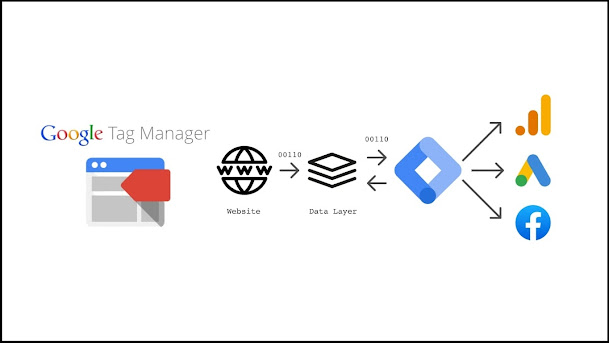What is Google Tag Manager & How Does it Work?
In the ever-evolving landscape of digital marketing, staying ahead of the curve is crucial for businesses looking to make an impact online. One tool that has become indispensable for managing and optimizing digital marketing efforts is Google Tag Manager (GTM).
Google Tag Manager is a free tool that allows you to configure and rapidly deploy tags on your website or mobile app using a simple web-based interface. It enhances the quantity and quality of information gathered while enabling marketers to quickly apply GTM tags without changing the code. An especially helpful tool is Google Tag Manager when combined with Google Analytics.
You can add and edit your own tags for conversion tracking, website analytics, remarketing, and other purposes using Tag Manager. You can change tags whenever you want thanks to the easy design, and there are practically unlimited methods to monitor activity across all of your websites and apps.
In this article, we’ll explore what Google Tag Manager is and delve into how it works in the realm of SEO services and digital marketing.
The key advantage of using GTM is its ability to centralize and streamline tag management. Without GTM, adding or modifying tags often requires manual coding, which can be time-consuming and error-prone. GTM offers a user-friendly interface that allows marketing professionals to implement and update tags without needing extensive technical knowledge.
How Does Google Tag Manager Work?
Container Setup: The core concept of Google Tag Manager revolves around the creation of a container. A container is a piece of code generated by GTM that you add to your website’s pages. It acts as a container for all the tags you want to manage.
- Tag Configuration: Within the GTM interface, you can configure various types of tags, triggers, and variables. Tags are typically snippets of JavaScript code provided by third-party services, such as tracking codes, pixels, or conversion scripts. Triggers determine when and where these tags are fired, while variables store dynamic information.
- Deployment: Once you’ve configured your tags, triggers, and variables in GTM, you publish your container, and the updated code is applied to your website. This means that when users interact with your site, GTM will trigger the appropriate tags based on predefined conditions.
- Real-time Tracking: Google Tag Manager offers real-time monitoring and debugging tools, allowing you to check if tags are firing correctly and troubleshoot any issues. This feature is particularly useful for ensuring that your SEO services and digital marketing efforts are running smoothly.
1. Improved SEO Tracking:
One of the primary objectives of SEO services is to track and measure website performance accurately. GTM enhances this process in several ways:
- Google Analytics Integration: GTM allows seamless integration with Google Analytics, a cornerstone tool for tracking website traffic and user behavior. By setting up Google Analytics through GTM, you can gain detailed insights into your website’s performance, including traffic sources, user demographics, and conversion rates.
- SEO-Related Tags: In addition to Google Analytics, GTM enables you to implement various other SEO-related tags. For example, you can easily deploy schema markup tags, which help search engines understand your content better and can lead to enhanced search result listings with rich snippets
- Keyword Tracking: GTM can be used to track keyword rankings through third-party SEO tools. By implementing the necessary tags, you can monitor how your website’s keyword positions change over time, allowing you to adjust your SEO strategy accordingly.
- User Behavior Analysis: GTM helps SEO professionals gain insights into user behavior on the website. You can track user journeys, engagement with specific pages, and the paths users take to reach conversion points. This data is invaluable for optimizing your content and improving SEO.
2. Quick Updates:
In the fast-paced world of SEO, agility is crucial. Here’s how GTM contributes to agility and the ability to respond swiftly to algorithm updates and SEO strategy changes:
- Tag Management Without Coding: With GTM, you can add, modify, or remove tags without the need to edit your website’s source code. This eliminates the risk of errors and speeds up the implementation of changes. When Google or other search engines release algorithm updates or new ranking factors, you can quickly adjust your tracking and measurement tags.
- Version Control: GTM provides version control and a historical record of changes made to your container. This allows you to roll back to previous versions if necessary, ensuring that your SEO tracking remains consistent and accurate.
- Real-time Updates: As soon as you publish changes in GTM, they take effect in real-time on your website. This is especially advantageous when implementing critical SEO fixes or optimizations that require immediate attention.
3. Enhanced User Experience:
A seamless and engaging user experience is not only essential for SEO but also for retaining and converting website visitors. GTM contributes to this by providing data and insights that can inform user experience improvements:
- User Behavior Insights: By tracking user interactions, clicks, and engagement with various elements on your website, GTM helps you understand what users find valuable and what might need improvement. You can identify high-traffic pages and optimize them for a better user experience.
- Page Speed Optimization: GTM can be used to implement tags for monitoring page load times and other performance metrics. By identifying slow-loading pages, you can take action to improve site speed, which is a crucial factor in both user experience and SEO rankings.
- Content Optimization: With GTM’s tracking capabilities, you can gather data on which content performs best. This information allows you to refine your content strategy, focus on what resonates with your audience, and create more of it to attract and retain users.
Google Tag Manager is an indispensable tool for SEO services, providing a streamlined way to track and measure website performance, respond swiftly to SEO updates, and enhance the user experience. By leveraging GTM’s capabilities, SEO professionals can gain a competitive edge by staying on top of their data and making data-driven decisions that drive organic search success.
Google Tag Manager's Role in Digital Marketing
Certainly, let’s dive deeper into the role of Google Tag Manager (GTM) in digital marketing. GTM plays a pivotal role in digital marketing by providing marketers with the tools they need to effectively manage, track, and optimize their online campaigns. Here, we’ll extensively elaborate on how GTM contributes to various aspects of digital marketing:
1. Conversion Tracking and Goal Measurement:
One of the fundamental aspects of digital marketing is tracking conversions and measuring campaign success. GTM makes this process efficient and accurate. Here’s how:
- E-commerce Tracking: For online businesses, tracking e-commerce transactions is vital. GTM allows you to integrate e-commerce tracking codes seamlessly. You can track sales, revenue, and product performance, gaining insights into which products or services are driving revenue.
- Event Tracking: Beyond e-commerce, GTM lets you track user interactions such as form submissions, downloads, video views, and button clicks. This data helps you understand user engagement and optimize your marketing strategies accordingly.
2. Personalization and User Engagement:
Personalizing the user experience is a cornerstone of modern digital marketing. GTM plays a crucial role in delivering personalized content and offers to your audience:
- User Behavior Tracking: GTM enables the tracking of user behavior on your website. You can monitor the pages they visit, the time they spend on each page, and the actions they take. This information is invaluable for segmenting your audience and creating personalized content.
- Dynamic Content Delivery: GTM can be used to deliver dynamic content based on user interactions. For instance, you can show tailored product recommendations or special offers to users who have previously shown interest in specific products or categories.
3. A/B Testing and Campaign Optimization:
Digital marketers are constantly striving to improve campaign performance through A/B testing and optimization. GTM facilitates these efforts:
- A/B Testing Implementation: GTM simplifies the setup of A/B tests by allowing you to deploy tracking and testing scripts without the need for code changes. This means you can quickly run experiments to determine which variations of your campaigns perform better.
- Real-time Data: GTM provides real-time data on how users are interacting with different variations of your campaigns. You can monitor metrics like click-through rates, conversion rates, and bounce rates to make data-driven decisions during your campaigns
4. Remarketing and Retargeting:
Remarketing and retargeting campaigns are powerful digital marketing strategies to re-engage users who have previously visited your website. GTM facilitates these efforts by:
- Tag Deployment: You can deploy tags for remarketing and retargeting platforms (e.g., Google Ads or Facebook Ads) through GTM. This allows you to create and target custom audiences based on specific user behaviors on your site.
- Customized Ad Campaigns: With GTM, you can segment your audience and serve them customized ads based on their previous interactions with your website. For example, you can show tailored ads to users who abandoned their shopping carts or visited certain product pages.
5. Data Integration and Cross-Channel Tracking:
In the multi-channel world of digital marketing, tracking user journeys across different touchpoints is essential. GTM helps you integrate and manage various tracking codes:
- Cross-Channel Tracking: GTM allows you to consolidate tracking codes from different platforms and marketing channels into one container. This means you can track user interactions consistently across your website, mobile apps, social media, email campaigns, and more.
- Data Layer: GTM’s data layer feature acts as a bridge between your website and various marketing tools. It allows for the seamless transfer of data, ensuring that information is accurate and consistent across your digital marketing ecosystem.
In conclusion, Google Tag Manager is an invaluable tool in the arsenal of digital marketers and SEO services providers. Its user-friendly interface, real-time tracking, and flexibility in managing tags, triggers, and variables make it an essential asset for optimizing websites, tracking performance, and driving digital marketing success. By harnessing the power of GTM, businesses can stay ahead in the competitive world of online marketing and SEO.
Article Resource Link-: https://creativeintelligent.com/what-is-google-tag-manager-how-does-it-work/






Comments
Post a Comment